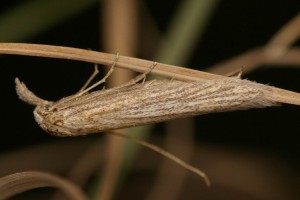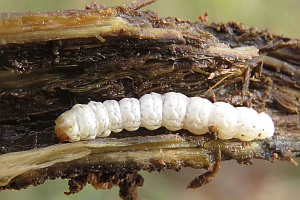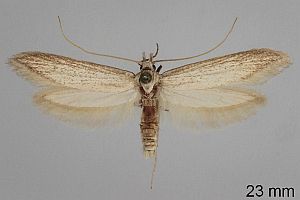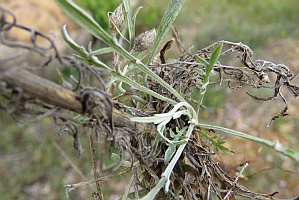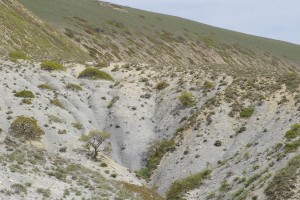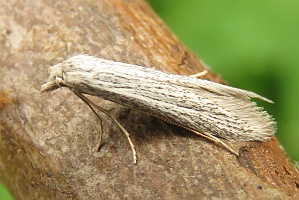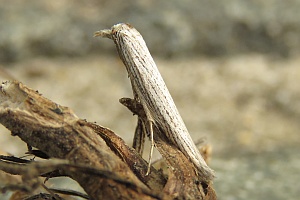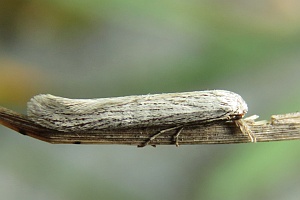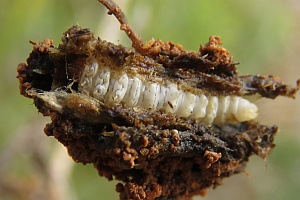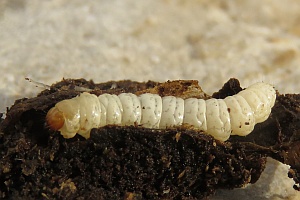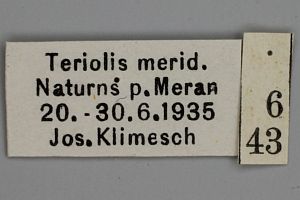1. Lebendfotos
1.1. Falter
1.2. Raupe
2. Diagnose
2.1. Geschlecht nicht bestimmt
2.2. Erstbeschreibung
3. Biologie
3.1. Nahrungspflanze
3.2. Habitat
3.3. Nahrung der Raupe
- [Asteraceae:] Centaurea diffusa (Sparrige Flockenblume)
- [Asteraceae:] Centaurea stoebe [= Centaurea rhenana, Centaurea maculosa] (Rispen-Flockenblume)
- [Asteraceae:] Centaurea vallesiaca (Walliser Flockenblume)
- [Asteraceae:] Centaurea cineraria ? (Aschgraue Flockenblume, Gelbe Flockenblume ?)
- [Asteraceae:] Centaurea friderici ?
Die Präimaginalstadien und die Biologie der Vertreter der Pterolonchidae blieben lange Zeit ganz unbekannt. Geändert hat sich das erst, als man in Nordamerika nach Insekten suchte, um einige aus Europa eingeschleppte Flockenblumen-Arten in den Griff zu bekommen. So nannten Harris & Cranston (1979: 381) erstmals Pterolonche inspersa als mögliches Agens zur Bekämpfung von Centaurea diffusa und C. maculosa [= C. rhenana]. Heppner (1997) erläutert: "Studies to possibly introduce Pterolonche inspersa Staudinger into the USA as a biological control agent for the knapweed plant pests have resulted in the first biological information for the family (Campobasso et al, 1994; Dunn et al., 1989). These studies on P. inspersa have also provided the first larval specimens for detailed morphological study." Nebst einer detaillierten Beschreibung aller Präimaginalstadien finden sich in der Arbeit auch Hinweise zur Lebensweise: "A study area in northern Greece showed P. inspersa to be univoltine, with adults active during July (Campobasso et al, 1994). Adult longevity is about 9-18 days, with males living fewer days than females on average. Oviposition occurs from late afternoon until midnight, with eggs laid at the base of the leaf rosette just above the ground surface, singly or in groups of 5-6 eggs. Females lay from 89-191 eggs each (Dunn et ai, 1989). After eggs are laid, larvae hatch in about 7-16 days and penetrate the root crown from the leaf rosette base. Larvae feed for about 11 months of the year, September to June. Larval feeding is in the root core and under the cortex." Und dann das für dieses Kapitel Wichtigste: "Hostplants of P. inspersa include only species of Centaurea: C. cineraria, C. diffusa, C. friderici, C. maculosa, and C. vallesiaca. Larvae are root borers of these knapweeds, making a silken webbing along the roots where feeding occurs." Bei den genannten Arten scheint es sich überwiegend (durchweg?) um Freiland-Raupenfunde zu handeln.
Dunn et al. (1989) hatten ihre Raupen bei Rom an Wurzeln von C. diffusa gesammelt. Campobasso et al. (1994: 378) berichten: "Schroeder (1977) reported P. inspersa infesting Centaurea diffusa, C. maculosa and C. vallesiaca (D. C.) Jordan. In northern Greece, Hungary, Yugoslavia, and Austria, P. inspersa was collected in roots of C. diffusa and C. maculosa (Campobasso, unpubl, data, 1980-1991). Müller (1984) collected it from roots of C. vallesiaca in northern Italy. Larvae were found on C. maculosa during surveys [Campobasso (1988-1989)] in Austria and Hungary." Damit ist von obiger Liste nur noch für C. cineraria und C. friderici unklar, ob es auch Freilandfunde gab - da die Raupen ex ovo an diesen beiden Flockenblumen gezüchtet werden konnten, scheint eine Nutzung im Freiland zumindest wahrscheinlich.
(Autor: Erwin Rennwald)
4. Weitere Informationen
4.1. Synonyme
- Pterolonche benesignata Rebel, 1914
- Pterolonche gracilis Rebel, 1916
4.2. Literatur
- Campobasso, G., Sobhian, R., Knutson, L., Pastorino, A. C. & P. H. Dunn (1994): Biology of Pterolonche inspersa (Lep.: Pterolonchidae), a biological control agent for Centaurea diffusa and C. maculosa in the United States. — Entomophaga, 39 (3/4): 377–384.
- Dunn, P. H., Rosenthal, S. S., Campobasso, G. & S. M. Tait (1989): Host specificity of Pterolonche inspersa [Lep.: Pterolonchidae] and its potential as a biological control agent for Centaurea diffusa, diffuse knapweed, and C. maculosa, spotted knapweed. — Entomophaga 34 (4): 435–446.
- Harris, P. & R. Cranston (1979): An economic evaluation of control methods for diffuse and spotted knapweed in Western Canada. — Canadian Journal of Plant Science, 59: 375-382. [PDF auf nrcresearchpress.com]
- Heppner, J. B. (1997): Immature stages of the mediterranean knapweed borer, Pterolonche inspersa (Lepidoptera: Pterolonchidae). — Holarctic Lepidoptera 4 (2): 63-66 [PDF auf troplep.org].
- Erstbeschreibung: Staudinger, O. (1859): Diagnose nebst kurzen Beschreibungen neuer andalusischer Lepidopteren. — Entomologische Zeitung 20 (7-9): 211-259. Stettin.




![Vorkommen in Russland (europäischer Teil bis Manytsch-Niederung) [Sinev (2021)]](/res/img/flag/ru.gif)
![Vorkommen auf der Krim [Sinev (2021)]](/res/img/flag/ua-kri.gif)
![Vorkommen in Tschechien [Laštůvka, Z. & J. Liška (2011): Komentovaný seznam motýlů České republiky]](/res/img/flag/cz.gif)

![Vorkommen in Ungarn [Pastorális et. al. (2018): A Magyarországon előforduló molylepke-fajok névjegyzéke]](/res/img/flag/hu.gif)
![Vorkommen in Frankreich (europäisches Territorium ohne Korsika) [Vandromme et al. (2020): Liste systématique et taxinomique des Lépidoptères de France]](/res/img/flag/fr.gif)
![Vorkommen in Spanien (Festland) [Vives Moreno A. (2014)]](/res/img/flag/es.gif)
![Vorkommen in Portugal (Festland) [Corley (2015): Lepidoptera of Continental Portugal]](/res/img/flag/pt.gif)
![Vorkommen in Italien (Festland und kleine festlandsnahe Inseln) [Baldizzone et al. (1995): Checklist delle Specie della Fauna Italiana 83]](/res/img/flag/it.gif)
![Vorkommen auf Sardinien [Baldizzone et al. (1995): Checklist delle Specie della Fauna Italiana 83]](/res/img/flag/it-sar.png)
![Vorkommen in Bulgarien [Soffner, J. (1967)]](/res/img/flag/bg.gif)
![Vorkommen in Griechenland (Festland und festlandsnahe Inseln) [Gozmany (2012): The Lepidoptera of Greece and Cyprus Volume I]](/res/img/flag/gr.png)
![Vorkommen auf Kreta [Gozmany (2012): The Lepidoptera of Greece and Cyprus Volume I]](/res/img/flag/gr.gif)
![Vorkommen auf Zypern [Gozmany (2012): The Lepidoptera of Greece and Cyprus Volume I]](/res/img/flag/cy.gif)
![Vorkommen im asiatischen Teil der Türkei [Koçak & Kemal (2018)]](/res/img/flag/tr.gif)
